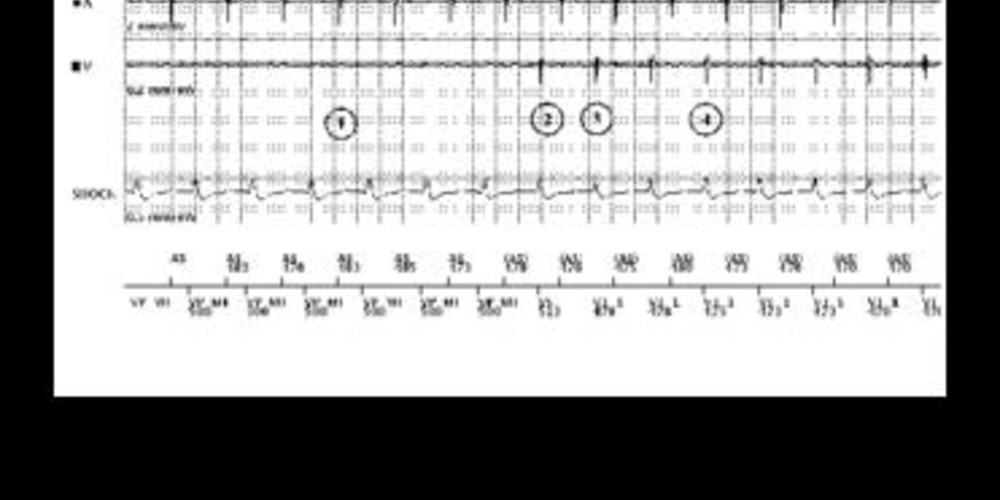Dual chamber discrimination, sinus tachycardia, Rhythm ID
Tracing
Manufacturer Boston Scientific
Device ICD
Field Discrimination
N° 5
Patient
This 66-year-old man underwent implantation of a Teligen dual chamber defibrillator for primary prevention, in the context of ischemic cardiomyopathy and old myocardial infarction. He was seen for a routine follow-up visit.
Summary
Episode detected in the VT-1 zone with Rhythm ID discrimination and identical atrial and ventricular rates.

Graph and trace
- sinus tachycardia with ventricular pacing at the maximum rate (MT: maximal tracking rate); gradual lengthening of the AV delay to prevent surpassing this maximum rate; this gradual lengthening favors the return of spontaneous conduction;
- return of spontaneous conduction with prolonged PR interval;
- the ventricular rate returned to the VT-1 zone;
- at the third consecutive cycle in the VT zone, the detection of an arrhythmic episode began; from this interval onward (5 cycles before the episode marker) the measurement of stability began. The mean variance was calculated over the next 5 intervals (4 variances);
- after 8 cycles in the VT-1 zone: V-Epsd;
- at the end of Duration, the decision was made not to treat because of the presence of a stable rhythm with concordance between the morphology during tachycardia and the reference morphology (RID+);
- cycle by cycle continuation of scrutiny of the stability and of the morphology; the rhythm remained stable with correlation of the vectors in a first stage;
- the rhythm was diagnozed as unstable for a single cycle, as the measured interval was longer (503 ms) than the preceding interval, and was thus classified outside the VT zone (VS); this longer cycle might be related either with a sudden prolongation of the PR interval or, more probably, with a slight delay of the time when the RV lead sensed the ventricular depolarization, a relatively frequent occurrence during effort. Since the vectors remained correlated with the reference vector, no therapy was delivered and the analysis continued;
- rhythm again considered stable;
- the sinus rhythm slowed, the ventricular EGM fell under the VT-1 zone and ventricular pacing resumed.
Other articles that may be of interest to you







This tracing shows a sinus tachycardia accurately discriminated by the device, as the patient was dancing at a party. The presence of correlated vectors, a 1:1 A:V rhythm and a stable rhythm suggest sinus tachycardia or atrial tachycardia/flutter. The clinical context, with gradual acceleration - deceleration is in favor of sinus tachycardia. Even if the discrimination was accurate and the device correctly identified SVT, it was probably acceptable, in this active patient who never developed episodes of ventricular arrhythmia, to raise the zone of VT detection to eliminate the overlap between physiologic accelerations of the sinus rate and the zones of VT detection prompting device therapies.